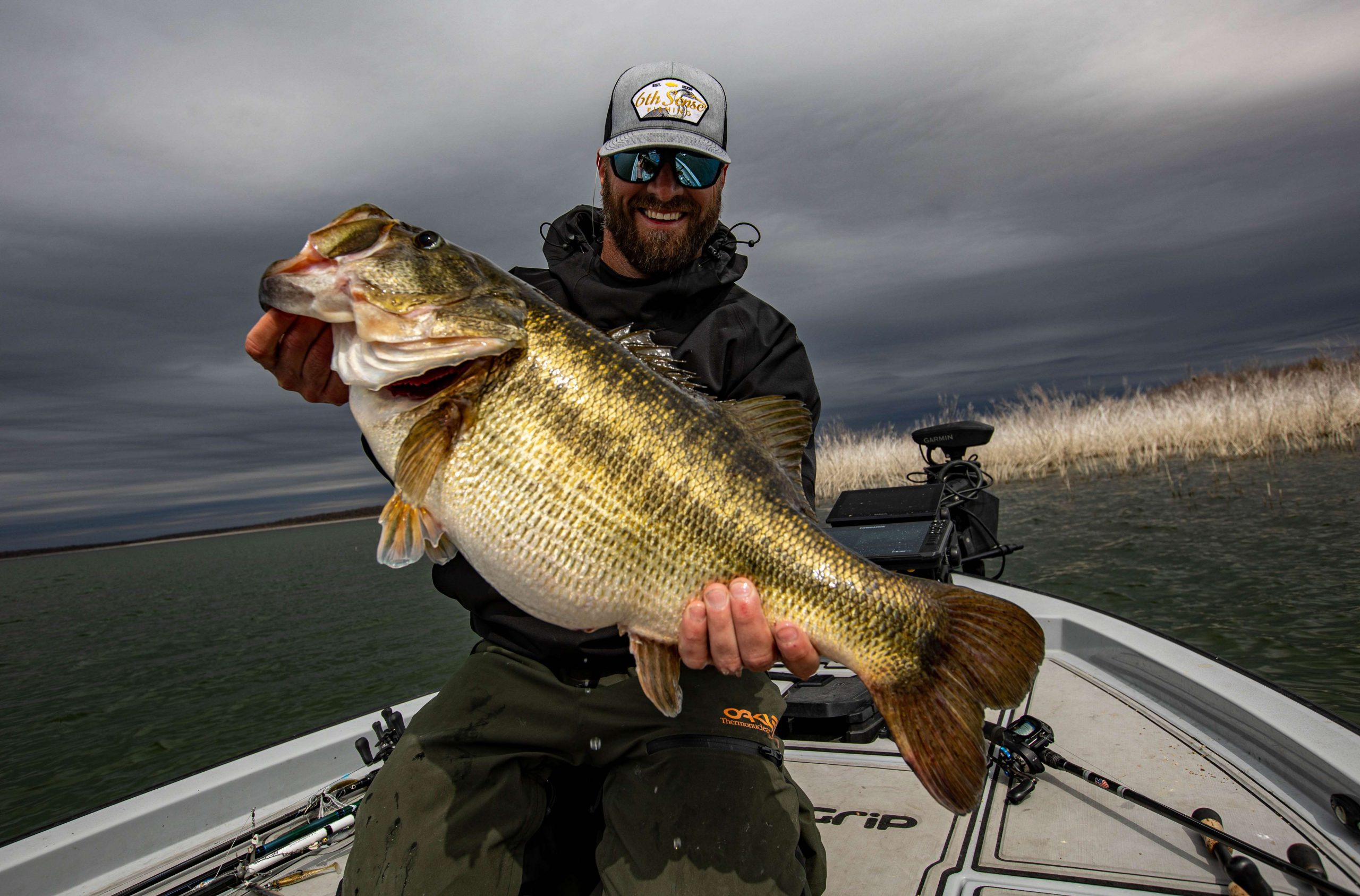
Everything is bigger in Texas.
Need proof?
Look no further than to O.H. Ivie Lake where records have been falling faster than temperatures during the Arctic blast that slammed the Lone Star State last month.
Six largemouth bass weighing more than 13 pounds were caught on Ivie in the 10-day stretch of Feb. 19-28, qualifying them as Legacy Class catches in the Texas Parks and Wildlife Department (TPWD) Toyota ShareLunker program. Legacy lunkers are fish that weigh at least 13 pounds and are caught during the spawning period from Jan. 1 to March 31. Biologists with TPWD use the massive bass in the agency’s selective breeding program which has helped produce record outputs at lakes around Texas though the past few decades.
Among the giants being pulled from Ivie recently – a 16.40-pound monster by Iowa’s Joe McKay [Read more about the huge catch], which was a lake record, breaking the old mark of 16.08 set in 2010. McKay’s mule was the 16th biggest largemouth in Texas history and the biggest bass caught statewide in 22 years. He hooked the bass on Feb. 19, part of a dream day when McKay and fishing partner Ben Milliken estimated their five heaviest bass weighed a total of 60 pounds.
Things didn’t slow down the following week, when Oklahoma’s Josh Jones caught lunkers weighing 13.20 and 15.40 on the 20,000-acre central-Texas reservoir near San Angelo. Donald Burks, Brett Cannon and Casey Sobczak also boated lunkers that week, weighing 13.40, 14.40 and 14.20 pounds, respectively.


In all, TPWD added eight Legacy Class bass to its ShareLunker list in those 10 days — six of them from Ivie and single Legacy catches coming from lakes Conroe and Travis. The amazing run brought the total number of 13-pounders caught in Texas this year to 12, triple the amount caught in the first three months of 2020.
It wasn’t just largemouth making news either. Texas angler Wyatt Frankens caught a 7.60-pound bass, and biologists aren’t sure if it is a smallmouth or a meanmouth. Either way, the fish is a record for O.H. Ivie Lake.
ShareLunker Program Coordinator Kyle Brookshear said the output is not unprecedented for O.H. Ivie, an impoundment of the Colorado River. Twelve Legacy bass were caught there in 2010 and another six came in 2011. Ivie’s biggest bass have been impressive, but the overall strength of the fishery is what’s most remarkable, he said.
“It’s not just the 13-pounders, but the 7-, 8-, 9-, 10-, 11-pounders. There have been a lot of them at Ivie recently, and they’re all extremely healthy.”
Brookshear said a combination of factors likely is responsible for the output, including stocking the lake with ShareLunker offspring in 2010 and 2011, as well as the higher water level in Ivie recently which has led to a vegetation and forage boom.
“We had a lot of rain in 2018, and it helped fill that lake back up,” he said. “All this vegetation and the nutrients developed in the soil are flooded, and you have what we call a ‘New Lake Effect.’ Everything is fertile, including the forage fish and the bass.”
The record-setting blizzard that plowed through Texas in mid-February was almost certainly a factor in the big bass bite too. Water temperatures were in the low 40s during the 10-day flurry of big catches, which may have triggered instincts for fish of all sizes to feed. Several anglers who caught lunkers at Ivie recently said the tails of forage fish dangled from the lunkers’ mouths when they got them onto their boats.
“The shad and the carp in there have never experienced such cold weather, and they were lethargic,” Sobczak said. “I think the big bass became arrogant because they could eat pretty much whatever they wanted. Typically that bait swims away.”
Sobczak, president of Texas-based 6th Sense Fishing, was fishing at Choke Canyon some four hours away with staff pros and the marketing team when they got word from Milliken about the phenomenal action at Ivie. They 6th Sense crew had only arrived at Choke Canyon a day earlier, and after struggling to catch quality bass, they decided to take the caravan north to Ivie.
Wise choice.
The first day at Ivie produced several 8- and 9-pound bass, but the action really heated up on day two.
“Choke (Canyon) was hurt by the freeze, but Ivie wasn’t,” Sobczak said. “It was incredible. That second day was one of the best I’ve ever had on the water. We caught between 75 and 100 bass that averaged about 3 pounds each. My top five that day weighed about 37 pounds total.”
A 14-2 lunker was among them too.


“When I hooked into her, I spoke jibberish,” he said. “I don’t know what I was saying. It was like hitting a stump.”
Cannon, the marketing manager at 6th Sense, caught his 14-4 on the same day as Sobczak.



“We were filming, so we were looking for the biggest bass we could find, and all we were getting were these 8s and 9s,” Cannon said, laughing. “I saw three giants on an underwater bush line, and I cast a few times and got nothing. But on the fourth one, she ate. It was like I was winching in a heavy weight. The water was really clear, so I could see her bug eyes, and she looked 40 inches long. My first instinct was, ‘I have a world record.’”
“I’m still emotional from it,” Cannon said. “It was the fish of 10 lifetimes.”
Members of the 6th Sense team were hammering the smallmouth bass too. Luke Dunkin caught a lake record 6-8 smallie before heading home to Tennessee. Zach Kinart, the sales manager at 6th Sense, blew the record away with a 7.47-pounder a couple days later, only to have Frankens grab what will be the new smallmouth record if biologists confirm the species.
“When I left, I pretty much knew my record wasn’t going to stand for long,” Dunkin said. “That’s how good the fishing was.”
Sobczak said all 6th Sense’s biggest bass were caught on umbrella rigs with a Sixth Sense Divine swimbait shad. He said some were caught on a 3.8-inch series, while others bit the 3.2-inch variety.
“I’ve never seen anything like it,” Sobczak said. “Ever. When lakes like Ivie or Falcon or Amistad flood, they have so much cover you can hardly get your boat in some spots. The lakes have really good spawns when that happens. And when the lake is coming back down, the bass get set up.
“It was like that at Ivie. The bushes were matted in 15 feet of water. There aren’t many tournaments on that lake and … it was a winter pattern. It was a perfect storm.”
Cannon agreed.
“Everything that needed to happen, did happen,’ he said. “But I don’t think it will happen again.”
Brookshear said it likely will, however, and there’s no telling exactly which of Texas’ world-class fisheries will turn on next.
“With good fisheries management and the right help from Mother Nature, it could happen just about anywhere.”





